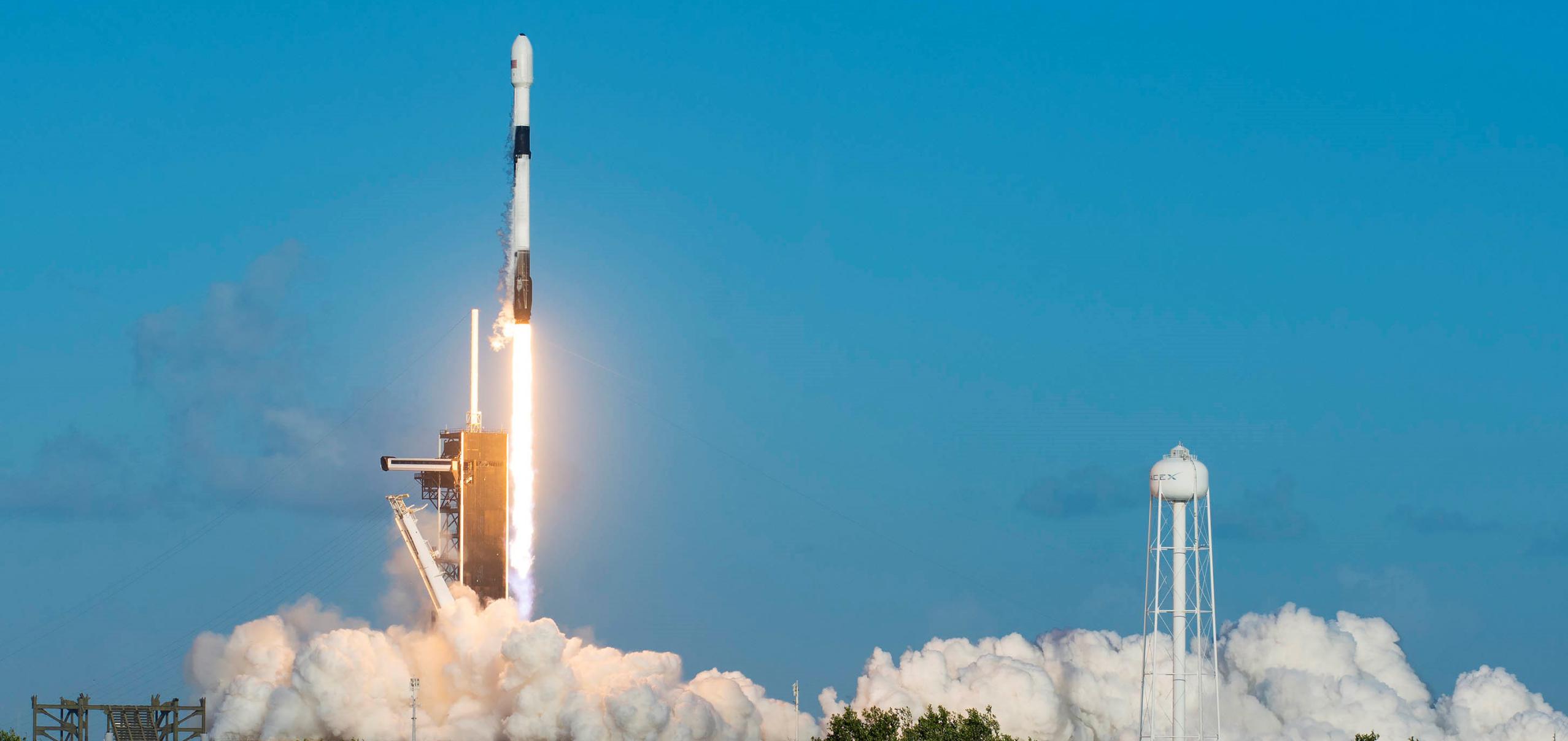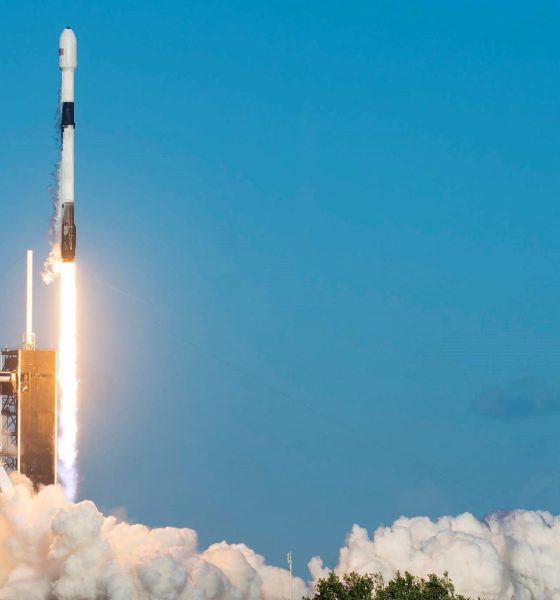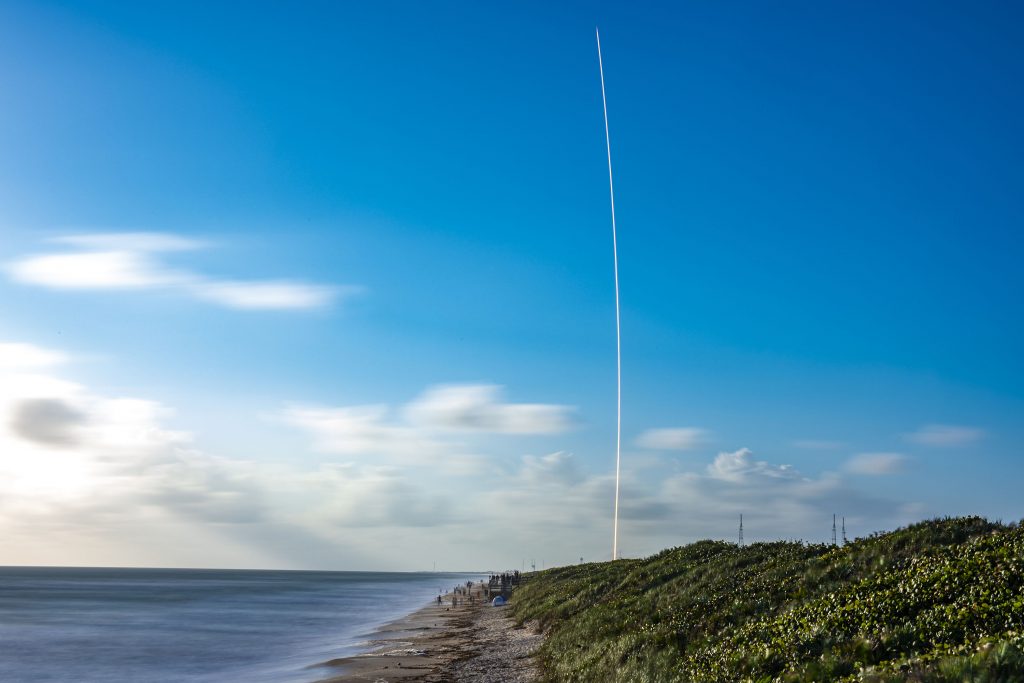

News
SpaceX orbits 60 more Starlink satellites, recovers booster, and catches fairing halves
SpaceX has successfully orbited another batch of 60 Starlink satellites, landed the Falcon 9 booster that launched it, and caught both halves of the rocket’s payload fairing.
Starlink-13 is now the second time ever that SpaceX has simultaneously recovered a Falcon 9 booster and caught both fairing halves on the same mission, coming just shy of three months after the first success.

The first full-fairing catch came just shy of three months prior, during SpaceX’s launch of ANASIS II military communications satellite for South Korea. SpaceX confirmed the back-to-back catch around an hour after Falcon 9’s July 20th liftoff, followed by onboard videos showing both catches.
For twin recovery ships GO Ms. Tree (formerly Mr. Steven) and GO Ms. Chief, the successful recovery effectively marked the first time that the pair achieved their design goal of whole-fairing recovery. Technically, SpaceX has already proven that fairing halves can be flown at least three times even after missed catches and ocean splashdowns, but avoiding saltwater immersion helps avoid corrosion and makes reuse far easier.
A step further, both of the Starlink-13 Falcon fairing halves SpaceX caught on October 18th had already launched twice before – the second and third times SpaceX has flown the same fairing half three times. Unfortunately, one of the two halves apparently tore through the receiving ship’s net when it was caught and could briefly be seen banging against the net’s supporting arms. SpaceX will have to determine if it suffered damage that might prevent future reuse.
Meanwhile, around thirty minutes prior to Ms. Tree and Ms. Chief’s second fairing recovery hat trick, Starlink-13’s assigned Falcon 9 booster successfully landed aboard drone ship Of Course I Still Love You (OCISLY). Designated B1051 and originally tasked with supporting Crew Dragon’s uncrewed orbital launch debut back in March 2019, Starlink-13 was the first stage’s sixth successful launch and landing, making it the second Falcon 9 booster to complete six flights.
For Starlink-13, the use – and successful recovery – of a five-flight booster and two-flight fairing likely means that the marginal cost of the mission to SpaceX was little more than the cost of propellant (< $500k) and Falcon 9’s expendable upper stage (~$10M), equivalent to an almost inconceivable ~$700 per kilogram of actual Starlink satellites launched. Assuming each Starlink satellite costs approximately $250k, it’s easy to believe that SpaceX is regularly launching 60 high-performance communications satellites for an all-in cost of just $25M-30M.
As an example of the impact of that extraordinary affordability, if SpaceX put the entirety of its latest $2B capital raise towards Starlink missions, it could likely complete 60-80 launches, placing some 3600-4800 new satellites in orbit. The entire first phase of SpaceX’s Starlink constellation – offering uninterrupted broadband internet anywhere on Earth – requires ~4400 satellites.
Coincidentally, Falcon 9 B1049 – the first booster to launch and land six times – was spotted just outside SpaceX’s Kennedy Space Center (KSC) LC-39A launch facilities the day (Oct 17) before B1051 lifted off from the same pad. The booster appears to be more or less waiting for its next flight, implying that all post-flight processing has already been completed since its last launch on August 18th.

Elon Musk
Elon Musk’s X will start using a Tesla-like software update strategy
The initiative seems designed to accelerate updates to the social media platform, while maintaining maximum transparency.

Elon Musk’s social media platform X will adopt a Tesla-esque approach to software updates for its algorithm.
The initiative seems designed to accelerate updates to the social media platform, while maintaining maximum transparency.
X’s updates to its updates
As per Musk in a post on X, the social media company will be making a new algorithm to determine what organic and advertising posts are recommended to users. These updates would then be repeated every four weeks.
“We will make the new 𝕏 algorithm, including all code used to determine what organic and advertising posts are recommended to users, open source in 7 days. This will be repeated every 4 weeks, with comprehensive developer notes, to help you understand what changed,” Musk wrote in his post.
The initiative somewhat mirrors Tesla’s over-the-air update model, where vehicle software is regularly refined and pushed to users with detailed release notes. This should allow users to better understand the details of X’s every update and foster a healthy feedback loop for the social media platform.
xAI and X
X, formerly Twitter, has been acquired by Elon Musk’s artificial intelligence startup, xAI last year. Since then, xAI has seen a rapid rise in valuation. Following the company’s the company’s upsized $20 billion Series E funding round, estimates now suggest that xAI is worth tens about $230 to $235 billion. That’s several times larger than Tesla when Elon Musk received his controversial 2018 CEO Performance Award.
As per xAI, the Series E funding round attracted a diverse group of investors, including Valor Equity Partners, Stepstone Group, Fidelity Management & Research Company, Qatar Investment Authority, MGX, and Baron Capital Group, among others. Strategic partners NVIDIA and Cisco Investments also continued support for building the world’s largest GPU clusters.
News
Tesla FSD Supervised wins MotorTrend’s Best Driver Assistance Award
The decision marks a notable reversal for the publication from prior years, with judges citing major real-world improvements that pushed Tesla’s latest FSD software ahead of every competing ADAS system.

Tesla’s Full Self-Driving (Supervised) system has been named the best driver-assistance technology on the market, earning top honors at the 2026 MotorTrend Best Tech Awards.
The decision marks a notable reversal for the publication from prior years, with judges citing major real-world improvements that pushed Tesla’s latest FSD software ahead of every competing ADAS system. And it wasn’t even close.
MotorTrend reverses course
MotorTrend awarded Tesla FSD (Supervised) its 2026 Best Tech Driver Assistance title after extensive testing of the latest v14 software. The publication acknowledged that it had previously criticized earlier versions of FSD for erratic behavior and near-miss incidents, ultimately favoring rivals such as GM’s Super Cruise in earlier evaluations.
According to MotorTrend, the newest iteration of FSD resolved many of those shortcomings. Testers said v14 showed far smoother behavior in complex urban scenarios, including unprotected left turns, traffic circles, emergency vehicles, and dense city streets. While the system still requires constant driver supervision, judges concluded that no other advanced driver-assistance system currently matches its breadth of capability.
Unlike rival systems that rely on combinations of cameras, radar, lidar, and mapped highways, Tesla’s FSD operates using a camera-only approach and is capable of driving on city streets, rural roads, and freeways. MotorTrend stated that pure utility, the ability to handle nearly all road types, ultimately separated FSD from competitors like Ford BlueCruise, GM Super Cruise, and BMW’s Highway Assistant.
High cost and high capability
MotorTrend also addressed FSD’s pricing, which remains significantly higher than rival systems. Tesla currently charges $8,000 for a one-time purchase or $99 per month for a subscription, compared with far lower upfront and subscription costs from other automakers. The publication noted that the premium is justified given FSD’s unmatched scope and continuous software evolution.
Safety remained a central focus of the evaluation. While testers reported collision-free operation over thousands of miles, they noted ongoing concerns around FSD’s configurable driving modes, including options that allow aggressive driving and speeds beyond posted limits. MotorTrend emphasized that, like all Level 2 systems, FSD still depends on a fully attentive human driver at all times.
Despite those caveats, the publication concluded that Tesla’s rapid software progress fundamentally reshaped the competitive landscape. For drivers seeking the most capable hands-on driver-assistance system available today, MotorTrend concluded Tesla FSD (Supervised) now stands alone at the top.
News
Elon Musk’s Grokipedia surges to 5.6M articles, almost 79% of English Wikipedia
The explosive growth marks a major milestone for the AI-powered online encyclopedia, which was launched by Elon Musk’s xAI just months ago.

Elon Musk’s Grokipedia has grown to an impressive 5,615,201 articles as of today, closing in on 79% of the English Wikipedia’s current total of 7,119,376 articles.
The explosive growth marks a major milestone for the AI-powered online encyclopedia, which was launched by Elon Musk’s xAI just months ago. Needless to say, it would only be a matter of time before Grokipedia exceeds English Wikipedia in sheer volume.
Grokipedia’s rapid growth
xAI’s vision for Grokipedia emphasizes neutrality, while Grok’s reasoning capabilities allow for fast drafting and fact-checking. When Elon Musk announced the initiative in late September 2025, he noted that Grokipedia would be an improvement to Wikipedia because it would be designed to avoid bias.
At the time, Musk noted that Grokipedia “is a necessary step towards the xAI goal of understanding the Universe.”
Grokipedia was launched in late October, and while xAI was careful to list it only as Version 0.1 at the time, the online encyclopedia immediately earned praise. Wikipedia co-founder Larry Sanger highlighted the project’s innovative approach, noting how it leverages AI to fill knowledge gaps and enable rapid updates. Netizens also observed how Grokipedia tends to present articles in a more objective manner compared to Wikipedia, which is edited by humans.
Elon Musk’s ambitious plans
With 5,615,201 total articles, Grokipedia has now grown to almost 79% of English Wikipedia’s article base. This is incredibly quick, though Grokipedia remains text-only for now. xAI, for its part, has now updated the online encyclopedia’s iteration to v0.2.
Elon Musk has shared bold ideas for Grokipedia, including sending a record of the entire knowledge base to space as part of xAI’s mission to preserve and expand human understanding. At some point, Musk stated that Grokipedia will be renamed to Encyclopedia Galactica, and it will be sent to the cosmos.
“When Grokipedia is good enough (long way to go), we will change the name to Encyclopedia Galactica. It will be an open source distillation of all knowledge, including audio, images and video. Join xAI to help build the sci-fi version of the Library of Alexandria!” Musk wrote, adding in a later post that “Copies will be etched in stone and sent to the Moon, Mars and beyond. This time, it will not be lost.”








